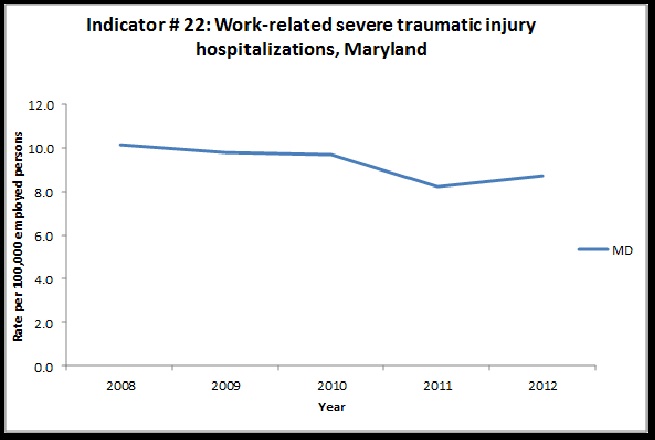Indicator #22: Work-related severe traumatic injury hospitalizations

Acute work-related trauma is a leading cause of death and disability among U.S. workers. Changes in hospitalization practices and workers’ compensation coverage/reporting may increasingly reduce capture of minor injuries but have little effect on severe injuries. Use of a severity threshold can decrease the impact of changing utilization and service delivery patterns on observed injury trends. When hospitalization data are used to calculate occupational injury trends in the absence of severity restriction, observed trends are biased downward. Accurate characterization of injury trends is critical to understanding how we are doing as a nation with regard to occupational injury prevention.
Graph

Table
Indicator # 22: Work-related severe traumatic injury hospitalizations, Maryland
| Year |
Number |
Rate * |
| 2008 |
292 |
10.2 |
| 2009 |
276 |
9.8 |
| 2010 |
273 |
9.7 |
| 2011 |
236 |
8.2 |
| 2012 |
253 |
8.7 |
* Rate per 100,000 employed persons
More about this Indicator
Why is this indicator important?
Acute work-related trauma is a leading cause of death and disability for U.S. workers. In 2010, more than 4,500 U.S. workers died from occupational injuries. Severe traumatic injury can lead to long-term pain and disability and is very costly for workers’ compensation systems and society as a whole. The total national medical and productivity cost for occupational injuries was recently estimated at $192 billion annually.
Data Source for this Indicator
Maryland Hospital Discharge Data (number of work-related hospitalizations).
Bureau of Labor Statistics’ Geographic Profile of Employment and Unemployment. For more information on this data source, visit: http://www.bls.gov/gps/.
Limitation of Indicator
Hospital discharge records are only available for non-federal, acute care hospitals. Many individuals with work-related injuries do not file for workers’ compensation or fail to recognize work as the cause of their injury. Additionally, self-employed individuals such as farmers and independent contractors, federal employees, railroad or longshore and maritime workers are not covered by state workers’ compensation systems. The expected payer on hospital discharge records may not be accurate and may not reflect the actual payer. Data between states may not be comparable due to the differences in states’ workers’ compensation programs. The indicator excludes patients hospitalized outside their state of residence. Severe traumatic injury hospitalizations are based only on first-listed ICD-9-CM diagnoses (following STIPDA/Safe States Alliance Consensus Recommendations, 2007) that have been estimated to have an Abbreviated Injury Scale (AIS) severity of 3 or above. As a result, some severe traumatic injuries will not be counted.

